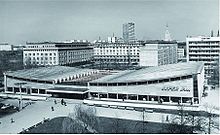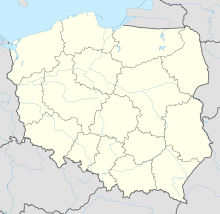Union of Lublin Square
 The Union of Lublin Square in 2022. | |
| Namesake | Union of Lublin |
|---|---|
| Location | Downtown, Warsaw, Poland |
| Coordinates | 52°12′49″N 21°01′17″E / 52.21361°N 21.02139°E |
| North |
|
| East | Bagatela Street |
| South |
|
| West | Boya-Żeleńskiego Street |
| Construction | |
| Completion | 1770 |
The Union of Lublin Square (Polish: Plac Unii Lubelskiej) is an urban square and a roundabout in Warsaw, Poland, within the Downtown district. It forms an intersection of Polna, Marszałkowska, Bagatela Puławska Street, Klonowa, and Boya-Żeleńskiego Streets, and Szucha Avenue. The square was constructed in 1770. It is surrounded by tenements.
Name
The name of the square refers to the Union of Lublin, an agreement signed in 1569, which led to the creation of the Polish–Lithuanian Commonwealth. The name was given on 1 July 1919, on the 350th anniversary of the signing of the document.[1][2]
Originally, it was known as the Mokotów Roundabout (Polish: Rondo Mokotowskie) due to its location near the village of Mokotów (now part of Warsaw).[3] Around 1875, it begun being known as the Kexholm Square (Polish: Plac Keksholmski; Russian: Кексгольмский площадь, transcription: Keksgol'mskiy ploshchad'), named after the nearby barracks of the Kexholm Life Guard Regiment of the Imperial Russian Army. The unit itself was named after the town of Priozersk in Russia, then known as Kexholm.[4]
History

The square was developed in 1770, as the southernmost part of the Stanisław Axix, an urban layout made of five circular squares and roads, connecting Warsaw with the Ujazdów Castle, developed from the initiative of king Stanisław August Poniatowski. The same year it was surrounded to the south and west by the Lubomirski Ramparts, line of fortifications erected around the city.[3]
In 1818, there were opened the Mokotów Tollhouses, which were two buildings set at the entrance to the city. They were designed by Jakub Kubicki in the Neoclassical style.[5]

In 1881, at the square was constructed a turning loop of a horsecar line, connecting it with Muranów.[6][7] In 1908, it was replaced with an electric tram line.[8]
In 1892, next to the square, between Puławska and Chocimska Streets, was opened the Warsaw narrow-gauge railway station (later renamed to Warsaw Mokotów in 1930). It was part of two lines operated by the Wilanów Railway. In 1898, there was also added a line of the Grójec Commuter Railway.[9][10] The station was moved in 1935 futher south, to the intersection of Puławska and Odyńca Streets, where it operated until 1938.[11]
At the beginning of the 20th century around the square were constructed the six- and eight-storey-tall tenements. This induced the Kacperski Tenement (1909), Bromke Tenement (1912), Łaski Tenement (1912), and Wielburski Tenement.[3]

On 11 November 1932, at the square was unveiled the Aviator Monument designed by Edward Wittig. It consisted of a sculpture of depicted an aviator holding a propeller, placed on a tall granite pedestal. It was destoryed by German forces in 1944, during the Second World War. Its replica was unveiled on 9 November 1967 at the intersection of Żwirki i Wigury, Wawelskiej, and Raszyńskiej Streets.[12]
In 1936, at 1 Polna Street near the square, was opened the headquarters building of the Warsaw Fire Guard, and its 3rd Division.[13] Later, until 2016, it was the headquarters of the State Fire Service, and currently, the headquarters of the city fire department.[14][15]
In 1938, it was planned to construct next to the square an office skyscraper designed by Bohdan Pniewski, as the headquarters of Polish Radio. Its construction begun in 1939, however it was soon stoped by the outbreak of the Second World War.[16][17]
In 1940, while under the German occupation, the square became part of the Police District, which was accessible only to German population, and in which were housed offices of occupant law enforcement structures, and the apartments for their employees.[18] At the square was also placed a station of the tram line no. 0, which was designated only for German passengers.[19]
On 1 August 1944, following the outbreak of the Warsaw Uprising, the square was captured by the Polish resistance fighters from the Jeleń Division. The unit continued fighting in the area for the next few following days, unsuccessfully attacking buildings in the Police District. It had suffered large loses, and was eventually forced to retreat.[4][20] In revenge for the attack, the German forces had massacred local Polish population. During and after the uprising, several buildings at the square were destroyed and burned down, including a few tenements and one of two tollhouses. They were rebuild after the war.[3]
In March 1946, there was set up a trolleybus line, connecting the square with the Gdańsk Station.[21]
In October 1948, in the Bromski Tenement, at 14 Bagatela Street, was opened the first book and newspaper store of Klub Międzynarodowej Prasy i Książki.[22][23] The company would eventually form Empik, one of the largest commercial chains in Poland that sells books, international press and media products.[24]

In 1962, at 2 Puławska Street, next to the square, was opened Supersam, a first supermarket in Poland. It was considered one of the best examples of the modern architecture in Poland.[25] The building was constructed in the location of the former railway station.[26]
In 1964, the roads at the square were renovated and remodeled, with the street layout being changed, and the tram tracks relocated to go through its middle rather than around it.[27] In 1965, it was given the status of a protected cultural property.[28]

On 1 July 1999, at the façade of the building at 15 Bagatela Street was unvailed a plaque commemorating the Union of Lublin. It was done on the 430th anniversary of its signing, and founded by the population of Lublin.[29]
Supersam was deconstructed in 2006.[30] In its place, in 2013 was opened Plac Unii skyscraper, that serves as an office building and a shopping centre.[31]
Characteristics

The Union of Lublin Square forms a roundabout at the intersection of Polna Street, Marszałkowska Street, and Szucha Avenue to the north, Bagatela Street to the east, Puławska Street and Klonowa Street to the south, and Boya-Żeleńskiego Street to the west. There are also two roads going through its middle, connecting Puławska Street with Marszałkowska Street and Szucha Avenue. There's also Trams tracks going through the middle, connecting Puławska and Marszałkowska Streets.[3][4]
The square is surrounded mostly by six- and eight-storey-tall tenements, including historical buildings dating to the early 20th century. They are: Bromke Tenement, Łaski Tenement, Kacperski Tenement, and Wielburski Tenement.[3] In the south, on both sides of Puławska Street are placed the Mokotów Tollhouses, two historical buildings dating to 1818.[5]
Next to the square, at 2 Puławska Street, is located the Plac Unii skyscraper, that serves as an office building and a shopping centre. It has the total heigh of 90 m (295.28 ft).[32]
The square has the status of a protected cultural property.[28]
References
- ^ Kwiryna Handke: Słownik nazewnictwa Warszawy. Warsaw: Slawistyczny Ośrodek Wydawniczy, 1998, p. 369. ISBN 83-86619-97X. (in Polish)
- ^ Jerzy Kasprzycki: Korzenie miasta, vol. 1: Śródmieście Południowe. Warsaw: VEDA, 2004, p. 110. ISBN 83-85584-45-5. (in Polish)
- ^ a b c d e f Eugeniusz Szwankowski: Ulice i place Warszawy. Warsaw: Państwowe Wydawnictwo Naukowe, 1970, p. 232–233. (in Polish)
- ^ a b c Encyklopedia Warszawy. Warsa: Wydawnictwo Naukowe PWN, 1994, p. 913. ISBN 83-01-08836-2. (in Polish)
- ^ a b Juliusz A. Chrościcki, Andrzej Rottermund: Atlas architektury Warszawy. Warsaw: Wydawnictwo Arkady, 1977, p. 208. (in Polish)
- ^ Stanisław Niewiadowski: Warszawa jakiej nie ma. Warsaw: Państwowy Instytut Wydawniczy, 1988, p. 183. ISBN 83-06-01615-7. (in Polish)
- ^ Stanisław Konarski: "Generał Sokrates Starynkiewicz, prezydent Warszawy", Rocznik Warszawski, issue 31. Warsaw, 2002, p. 227. (in Polish)
- ^ Warszawskie tramwaje elektryczne 1908−1998, vol. 1. Warsaw: Wydawnictwa Komunikacji i Łączności, 1998, p. 6. ISBN 83-907574-00. (in Polish)
- ^ Jarosław Zieliński: Plac Unii i okolice. Warsaw: EKBIN Studio PR, 2013, p. 39–40. ISBN 978-83-929745-4-3. (in Polish)
- ^ "Warszawa Mokotów". atlaskolejowy.pl (in Polish).
- ^ Hanna Faryna-Paszkiewicz: "Pierwsza wąskotorówka", Skarpa Warszawska, issue 9 (66). Warsaw, September 2014, p. 10. (in Polish)
- ^ Encyklopedia Warszawy. Warsaw: Wydawnictwo Naukowe PWN, 1994, p. 664. ISBN 83-01-08836-2. (in Polish)
- ^ Ryszard Mączewski: Warszawa między wojnami. Łódź: Księży Młyn, 2009, p. 69. ISBN 978-83-61253-51-8. (in Polish)
- ^ "Nowa siedziba KW PSP Warszawa oficjalnie otwarta!". strazacki.pl (in Polish). 10 October 2016.
- ^ "Komenda Miejska Państwowej Straży Pożarnej m. st. Warszawy". gov.pl (in Polish).
{{cite web}}: line feed character in|title=at position 16 (help) - ^ Grzegorz Mika: Od wielkich idei do wielkiej płyty. Burzliwe dzieje warszawskiej architektury. Warsaw: Agencja Wydawniczo-Reklamowa Skarpa Warszawska, 2017, p. 194–195. ISBN 978-83-63842-67-3. (in Polish)
- ^ Anna Cymer. "Niezrealizowany projekt siedziby Polskiego Radia". culture.pl (in Polish).
- ^ Tomasz Szarota: Okupowanej Warszawy dzień powszedni. Warsaw: Czytelnik, 2010, p. 371. ISBN 978-83-07-03239-9. (in Polish)
- ^ Warszawskie tramwaje elektryczne, vol 2. Warsaw: Wydawnictwa Komunikacji i Łączności, 1998, p. 27–28. ISBN 83-907574-00. (in Polish)
- ^ Adam Borkiewicz: Powstanie warszawskie. Warsaw: Instytut Wydawniczy Pax, 1969, p. 63–64. (in Polish)
- ^ "Kronika wydarzeń w Warszawie 1945−1958", Warszawskie kalendarz ilustrowany 1959. Warsaw: Wydawnictwo Tygodnika Ilustrowanego Stolica, 1958, p. 30. (in Polish)
- ^ Władysław Bartoszewski, Bogdan Brzeziński, Leszek Moczulski: Kronika wydarzeń w Warszawie 1939–1949. Warsaw: Państwowe Wydawnictwo Naukowe, 1970, p. 178. (in Polish)
- ^ Julian Bystrzanowski, Konrad Dutkowski: Wszystko o Warszawie. Informator. Warsaw: Wydawnictwo Sport i Turystyka, 1975, p. 163. (in Polish)
- ^ "W internecine od 15 lat, w realu od 65. Oto historia Empiku". interaktywnie.com (in Polish). 16 September 2013.
- ^ T. Przemysław Szafer: Współczesna architektura polska. Warsaw: Arkady, 1988, p. 227. ISBN 83-213-3325-7. (in Polish)
- ^ Symeon Surgiewicz: Warszawskie ciuchcie. Warsaw: Wydawnictwo Ministerstwa Obrony Narodowej, 1972, p. 18. (in Polish)
- ^ "Wydarzenia warszawskie na łamach prasy w roku 1964", Warszawski Kalendarz Ilustrowany 1966. Warsaw: Wydawnictwo Warszawskiego Tygodnika Stolica, 1965, p. 148. (in Polish)
- ^ a b "Zestawienia zabytków nieruchomych. Wykaz zabytków nieruchomych wpisanych do rejestru zabytków - stan na 30 września 2018 r.. Woj. mazowieckie (Warszawa)". nid.pl (in Polish).
- ^ Stanisław Ciepłowski: Wpisane w kamień i spiż. Inskrypcje pamiątkowe w Warszawie XVII–XX w. Warsaw: Argraf, 2004, p. 30. ISBN 83-912463-4-5. (in Polish)
- ^ Jarosław Trybuś. "Wyburzenie warszawskiego Supersamu (2006) – przełom w społecznym postrzeganiu dziedzictwa powojennego modernizmu". nck.pl (in Polish).
- ^ "Znamy datę otwarcia centrum handlowego Plac Unii". warszawa.wyborcza.pl (in Polish). 30 September 2013.
- ^ "Plac Unii City Shopping. Warszawa, Puławska 2". urbanity.pl (in Polish).
External links
 Media related to Union of Lublin Square at Wikimedia Commons
Media related to Union of Lublin Square at Wikimedia Commons
- Pages using gadget WikiMiniAtlas
- CS1 Polish-language sources (pl)
- CS1 errors: invisible characters
- Articles with short description
- Short description with empty Wikidata description
- Coordinates on Wikidata
- Commons category link is on Wikidata
- Squares in Warsaw
- Śródmieście Południowe
- Ujazdów, Warsaw
- 1770 establishments in the Polish–Lithuanian Commonwealth
- Transport infrastructure completed in 1770
- Roundabouts and traffic circles in Poland
- Buildings and structures completed in 1770
